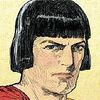- beak
- Key Master
 Offline
Offline 
- From: Qld Australia
- Registered: 24-3-2013
- Posts: 929
Re: Typeface database

Remington portable no. 1. Typeface is 10 cpi.
Last edited by beak (19-12-2013 07:57:07)
Sincerely,
beak.
- Valiant
- Touch Typist
 Offline
Offline 
- From: Toronto
- Registered: 12-3-2013
- Posts: 153
Re: Typeface database
Re: type testing
Beak, I notice that you use a double space after a period. That's classic typewriting style!
I'm going to post a couple of machines to the new acquisitions thread shortly, and include type tests for them in that thread. I like to see the machine + font together. I suppose I could post the font here, as well, if you think it's more instructive to keep font samples in one thread.
"Now is the time for all good men to come to the aid of the typewriter."
- beak
- Key Master
 Offline
Offline 
- From: Qld Australia
- Registered: 24-3-2013
- Posts: 929
Re: Typeface database
I've never done anything else other than double-space after the full stop - I was classic without even knowing it! True, seeing machine and type together is good - edited above to include picture.
Now, does anyone know how to describe the type SIZE correctly; 10pt, 11pt,12pt etc. - is it the number of letters within one inch (top - 12 in this example) or the number of letters centre to centre (bottom - 13 in this example)?
As to where to put samples - very much as you please, I'd say, though I thought it would be good to have a thread just for those interested in the type graphics. Both seems best!
I'm just experimenting with Photoshop to find a good way to superimpose the typefaces of my two Remington portables while keeping them life-size. Though made only a few years apart, the two types have many identifyable differences. Other suggestions always welcome, of course.
Last edited by beak (14-5-2013 19:21:38)
Sincerely,
beak.
- •
- Shangas
- Speed Champion
 Offline
Offline - From: Melbourne, Australia
- Registered: 17-3-2013
- Posts: 298
Re: Typeface database
What a beautiful Remington Portable, Beak! Must be a true joy to use!
"Not Yet Published" - My History Blog
"I just sit at a typewriter and curse a bit" - Sir Pelham Grenville "P.G." Wodehouse
"The biggest obstacle to professional writing is the necessity for changing a typewriter ribbon" - Robert Benchley
- beak
- Key Master
 Offline
Offline 
- From: Qld Australia
- Registered: 24-3-2013
- Posts: 929
Re: Typeface database
Shangas wrote:
What a beautiful Remington Portable, Beak! Must be a true joy to use!
Yes it really is surprising pleasant to use, considering its age. A great piece of engineering, IMO.
To think that this was valued at no more than $20 by the previous owner is very odd to me - is it only us who can see it? Or are they just more sensible than we! I wonder what he spent the $20 on - as a comparison of interests.
Sincerely,
beak.
- •
- Steve Stephens
- Platen Punisher
 Offline
Offline - From: San Francisco Bay Area, Calif.
- Registered: 13-3-2013
- Posts: 55
Re: Typeface database
beak wrote:
Now, does anyone know how to describe the type SIZE correctly; 10pt, 11pt,12pt etc. - is it the number of letters within one inch (top - 12 in this example) or the number of letters centre to centre (bottom - 13 in this example)?
Beak, I copied the following from the Yahoo Typewriters Group which may answer your question and was interesting to me.
Posted by "yahuism" Wed Mar 13, 2013 9:59 am
Ned's answer below is quite correct and I would like to add even more
clarification, maybe even make this the resource you have been searching for. My
qualifications include the fact that I am a professional book designer, a former
typewriter salesman, and an old guy who lived in the typewriter era.
Pica and elite do not designate fonts nor typefaces; in the typewriter realm, at
least in the US, "pica" means _only_ 10 characters per inch horizontally and
"elite" means _only_ 12 characters per inch. Nothing more than that, not a
style, not a design, not a size. This spacing in cpi is called "pitch".
In the typewriter realm, at least in the US, "roman" means that the characters
are "straight up and down" and refers to both serif and sans serif* faces.
"Italic" means the characters are like the roman, but slanted. And "script"**
refers to a "swoopy" style that is supposed to mimic handwriting. Royal's
distinctive Vogue is classed as a roman. Some early European typewriters used
that dense, dark style called Fraktur, and today we pretty much have to call it
that, but there aren't many such unusual typefaces. What we have been calling
"Techno" is a roman design, as are those computerish OCR typefaces.
None of the terms above designate actual typeface designs--there is no pica
typeface. That's why people say, "Your Pica doesn't look quite like my Pica";
it's because there is not a particular Pica in the first place.
Typeface designs often--usually--do have particular names, especially in the
letterpress and computer worlds. In the typewriter world those names are rarely
generally known and in any case they are named by each manufacturer, with no
concern for how another maker might use the same name. When Pica and Elite are
used in a maker's catalog to designate a typeface, it is their own arbitrary
usage. See Ted Munk's wonderful presentation of the NOMDA type catalogs for an
entry to this wide world, at <a href=
"\
p://munk.org/typecast/2011/04/23/1964-nomda-blue-book-facit-font-styles</a>.
Beyond that, a typeslug code is usually cast into the slugs, in very tiny
characters between the upper- and lower-case characters. These were used for the
typewriter maker to specify exactly what design they wanted to buy from the
foundry and to keep that business organized. Nowadays we are using those codes
to learn things about our machines' histories. The "E"s and "P"s that appear
there might sometimes indicate pica and elite but I doubt they always do, and
anyway I'll bet that the same typeslugs were sometimes used for both pica
(10cpi) and elite (12 cpi) machines. Note that Smith Corona's Changeable Type
was not offered in pica and elite versions but is perfectly usable on both
spacings.
In the end, I think Ned's approach is a good one for us general
collectors--record the style and the pitch and call it good. I'm sure someone
someday will tabulate all that is known about the codes and the catalog names,
but what we are most interested in is how it looks on the page and what we can
expect from eBay.
== Michael Höhne
* Sans serif is often called "gothic" in the business, leading to confusion with
the popularly-understood gothic as meaning the blackletter or fraktur or "Olde
English" style.
** Script is also called "cursive" but in the typewriter realm, script is the
preferred term and cursive is reserved to the world of actual handwriting.
________________________________________________________________________
>
> On 3/12/2013 11:55 PM, jim.donahue61 wrote:
> > Greetings fellow typophiles,
> >
> > Can anyone tell me how you identify the font on your typewriter (ie,
> > Pica, times new roman etc)? I have an underwood universal and there
> > appears to be some type of stylized "UF" on the typebars, with the
> > u superimposed over the f. (or maybe it's a U-P with the U superimposed on
the P?) Is this a proprietary font of
> > underwood? I can't find a resource online about it.
> >
> --- In TYPEWRITERS@yahoogroups.com, Ned Brooks <nedbrooks@...> wrote:
>
> I have been recording the mark on the slug face, if any. But as far as
> the font goes, all I have used are the pitch (pica=10cpi, elite=12cpi)
> and Roman, Italic, or Script. But because there are lots of machines
> that are not pica or elite (cpi may be 6, 9, 11, 16, or not even an
> integer for European machines), I don't use those words at all but just
> put the cpi number. I don't see much point in trying to use the fancy
> proprietary font names - there is no general key as to how they relate
> to the slug face mark. And there have been many variations of "Roman",
> but I think "Times New Roman" is a proportional TTF computer font.
- beak
- Key Master
 Offline
Offline 
- From: Qld Australia
- Registered: 24-3-2013
- Posts: 929
Re: Typeface database
Thanks - this is all useful stuff.
Still a bit unsure, though, on the correct way to measure the size of the typeface - inclusive or centre to centre.
Sincerely,
beak.
- •
- Steve Stephens
- Platen Punisher
 Offline
Offline - From: San Francisco Bay Area, Calif.
- Registered: 13-3-2013
- Posts: 55
Re: Typeface database
An easy way is to see how many numbers there are per inch on the scale in front of the platen. I can tell a pitch of, say, a Smith Corona portable from c.1950 if I can see how high the scale goes.
You can also check to see how many clicks of the spacebar will move the carriage one inch. I think that how many letters fit into one inch is what you want to find out.
Your sample shows two ways and I think both give the same result.
- beak
- Key Master
 Offline
Offline 
- From: Qld Australia
- Registered: 24-3-2013
- Posts: 929
Re: Typeface database
Steve Stephens wrote:
............. .....
Your sample shows two ways and I think both give the same result.
Ah - no - this is my whole point; the top sample shows 12 characters contained within one inch, and the bottom shows 13 characters over a distance of one inch when they are measured centre (of letter) to centre.
Perhaps this answers itself IF there is no such thing as 13pt!
Sincerely,
beak.
- •
- Valiant
- Touch Typist
 Offline
Offline 
- From: Toronto
- Registered: 12-3-2013
- Posts: 153
Re: Typeface database
beak wrote:
Steve Stephens wrote:
............. .....
Your sample shows two ways and I think both give the same result.Ah - no - this is my whole point; the top sample shows 12 characters contained within one inch, and the bottom shows 13 characters over a distance of one inch when they are measured centre (of letter) to centre.
Perhaps this answers itself IF there is no such thing as 13pt!
Beak, I don't think 'point size' applies to the way typewriter fonts are measured. Point size refers to the height of a character, not how many characters fit per inch. See:
(handwriting)
"Now is the time for all good men to come to the aid of the typewriter."


